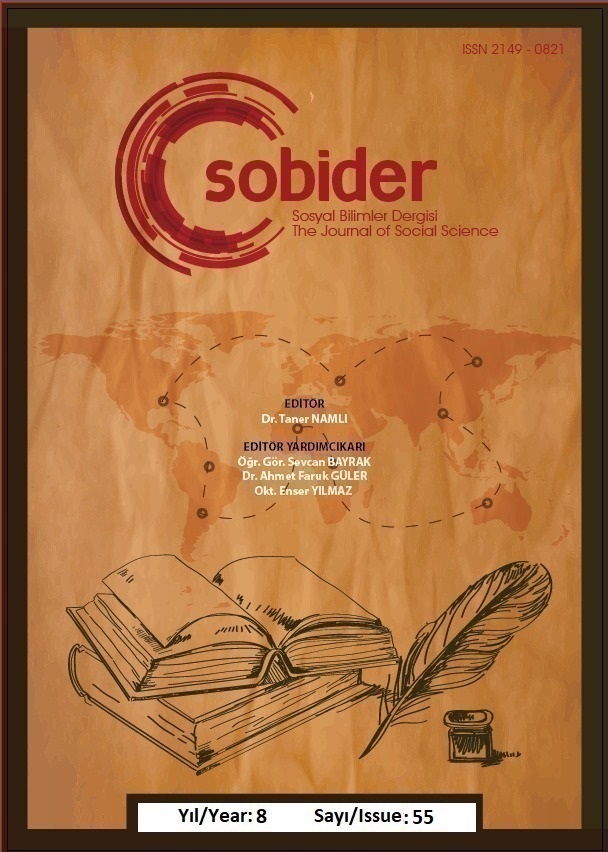Author :
Abstract
Türkler’de kuleler, türbeler, dikilitaşlar ve gözetleme kuleleri anıtsal yapılar olarak ortaya çıkmaktadır. Batı anlamında heykel sanatı ise Osmanlı’da Tanzimat Dönemi’nden sonra gelişmiş Lale Devri’nde bezeme motifleri kabartma heykellere dönüşmüştür. Modernleşme ile birlikte Türkiye’de anıt-heykeller ortaya çıkmıştır.19.yüzyıl sonunda anıt mantığının terk edilmesi, modernist heykelin 1950’li yıllarda tükenişi ile heykel hem mekanhem mimariyi kapsayacak biçimde bir dönüşüm süreci yaşamıştır Kübizmle başlayan yüzeyle uğraşma ve yapı bozumu, fütürizmle beraber bir hareket arayışına girmiştir. Toplumsal yaşamın aynası olan tüm sosyal mekanlar da değişim süreçlerinin sonucu olarak değişmekte ve yeniden yapılanmaktadırlar. Ve artık büyük kentlerindeki kamusal alanlar, çağdaş sanatçılar tarafından işlevsel bir sanat platformu olarak kullanılmaktadır.
Keywords
Abstract
Towers, tombs, obelisks and watchtowers appear as memorial buildings for Turks. It was only after Tanzimat period that sculpturing in western sense developed in Ottomans and relief motives of Lale Era were converted to sculptures. With modernity movements memorial-sculptures have appeared in Turkey. On leaving the sense of memorial at the end of 19th century and on consuming modernist heykel in 1950’s, sculpturing has experienced a transformation process including site and also architecture. Dealing with the surface and the alteration of structure caused by cubism were in the search of a movement with futurism. As the reflector of social life, all social sites change and get reformed as the result of processes of reforms. Public places in great cities are being used as functional art platforms by modern artists.
Keywords
- Antoinnette,L.N. (1986 ).Sculpture, Cenova,
- Apa,A. (2002 ).’’Üzerinde Konuşulan,Okunan Ve Görülen Bir Heykel’’, Sanat Dünyamız Dergisi, S.82, İstanbul, 133-137.
- Altıntaş, O. ( 2007 ) . Sanat Eğitimi Ve Çağdaş Türk Resminde Nü, Ankara
- Baraski , C.( 1964 ).Heykel Hakkında Genel Bilgiler,Bükreş.
- Buren,D. (2000 ).’’Kente Yerleşmek’’, Sanat Dünyamız Dergisi, S.78, İstanbul, 133-145.
- Bulat , M. (2007 ).’’Modern Heykelin Doğuşu’’, Sanat Dergisi, S.XI, Erzurum, 83-89.
- Bulat , M. (2007 ).’’Form Ve Kompozisyon’’, Sanat Dergisi, S.XII, Erzurum, 73-78.
- Bulat, M. - Babyev, G. -Bulat, S. ( 2004 ). Heykel Atölye, İstanbul.
- Habermas, J.( 2003) . Kamusallığın Yapısal Dönüşümü, (Çev. Bora, T. – Ancar, M),İstanbul.
- Huntürk,U,.(1996). Heykel Sanatı,, İstanbul .
- Demirkalp, M.(2008).“Şehirsel Çevre ve Heykel” Sanat(G. S. Fak. Der.)sayı:13 s.112
- Eczacıbaşı Sanat Ansiklopedisi,(1997).C.2.II,İstanbul.
- Ergin, Nilüfer (1993), Kent Mekanlarındaki Heykeller ve Ağaç
- Ergin,, Nilüfer (1998), “Heykel ve Çevre İlişkisi”, Sanatta Yeterlik
- Germaner,S..,Eczacıbaşı SanatAnsiklopedisi,(1997).Cilt.2,İstanbul.
- Gombrıch, E. ( 1986 ).Sanatın Öyküsü, İstanbul.
- Güneş,G. (2005). An AlternativeApproachfor Analysis of Traditional Shopping Spacesand a Case StudyonBalıkesir, Trakya UniversityJournal of Science, S.VI, No. 1, S. 63- 75.
- Güner,A.-Çağdaş,G. (1996).Alışveriş Merkezlerinde,Rekreasyonel İç Mekan Organizasyonu,İstanbul.
- Özbek, M. (2004). Kamusal Alan, İstanbul.
- Görmez, K. (2003), Çevre Sorunları ve Türkiye, Ankara
- Gürsel, Y.(1992), Mimarlık ve Çevre, İstanbul
- Güvemli, Z .( 1982 ).Sanat Tarihi, İstanbul.
- Huot, J-L, Thalmann, J-P, Valbelle, D. (2000), Kentlerin
- Kabaş, Ö.(1976), Tüm Çevresel Gerçekçilik Bildirişim ve
- Karaaslan, S.(1993), “Kentsel Doku İçinde Yer Alan Açık
- Kınay, C. ( 1977 ). Sanat Tarihi, Ankara.
- Kılıçbay, M. A.(2000), Şehirler ve Kentler, Ankara.
- Koman, İlhan (2005), İlhan Koman Retrospektif, İstanbul: YKY
- Korkmaz, E. (2002 ).Kentsel Kamusal Mekanda Değer Yaratma Yaklaşımında Katılımcı Bir model Önerisi,( Yayınlanmamış Doktora Tezi).
- Lynton, N. (1991 ). Modern Sanatın Öyküsü,1991, İstanbul.
- Lynton, N. ( 1982 ). Modern Sanatın Öyküsü, İstanbul.
- Ögel, S. (1977), Çevresel Sanat, İstanbul.
- Özsezgin, K. (2005), İlhan Koma,İstanbul.
- Öztürk,K.B.,(2005).Açık Alanlarda Heykel-Çevre İlişkisi ve Tasarımı (ErciyesÜni.Mim.Fak. Şehir ve Böl. Pla.Böl. Kayseri.
- Renda,G. (2002 ).’’Osmanlı’da Heykel’’, Sanat Dünyamız Dergisi, S.82, İstanbul, 139-1143.
- Rosalınd,K. (2002 ).’’Mekana Yayılan Heykel’’, Sanat Dünyamız Dergisi, S.82, İstanbul, 103- 110.
- Savaş, R. ( 1975 ). Modelaj, Ankara.
- Şeref , B.(1984). Resim Sanatı.Ankara.
- Turani, A. ( 1983 ). Dünya Sanat Tarihi, Ankara.
- Turani,A.(1974). Çağdaş Sanat Felsefesi,Ankara.
- Tanyeli, U.(2000). Kent: Hazır-Yapıt, Sanat Dünyamız Dergisi Sayı:78, İstanbul,
- Yardımcı, İ. (2011) .’’Pekin Olimpiyatları Kapsamında Bir Kamusal Alan Heykeli Uygulaması ‘Prizmanın Telaşı’,Dokuz Eylül Üniversitesi Güzel Sanatlar Enstitüsü Heykel Ana Sanat Dalı Yayınlanmamış Sanatta Yeterlilik Tezi, İzmir.
- Yerlikaya,N. (2002 ).’’Osmanlı’da ve Cumhuriyet’te Anıt-Heykeller Ve Kentsel Mekan’’, Sanat Dünyamız Dergisi, S.82, İstanbul, 147-153.
- Yılmaz, S. ( 2000). Resimde Geometri İlişkisi, (Yayınlanmamış Lisans Tezi).Isparta.
- Tandırlı,E. (2005),Kamusal Alanda sanatın Yeni Yüzü Ve Thomas Hirschhon,Beykent Üni., G. S. Fak.Res.Böl.İstanbul.
- Williams, K. (1993). Kültür,Çev.Aydın,S.,Ankara.
- Tdk.gov.tr.8.6.2013 de internetten indirilmiştir.
